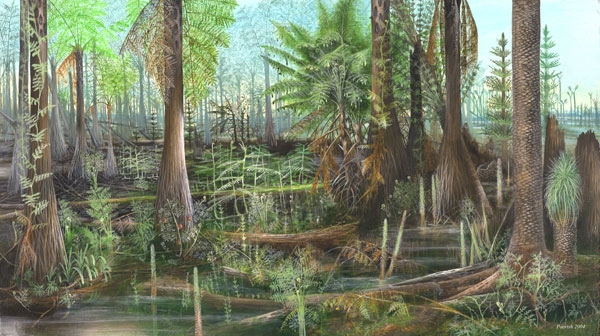Geologisch Monument "Terziet" EarthCache
Geologisch Monument "Terziet"
-
Difficulty:
-

-
Terrain:
-

Size:  (not chosen)
(not chosen)
Please note Use of geocaching.com services is subject to the terms and conditions
in our disclaimer.
| I have earned GSA's highest level: |
 |
English:
An Earthcache is an educational form of a virtual cache. The reward for these caches is learning more about the planet on which we live - its landscapes, its geology or the minerals and fossils that are found there.
You can park your car shortly nearby the sign in front of the white electrical house.

The Carboniferous is a geologic period and system that extends from the end of the Devonian Period, to the beginning of the Permian Period. It has lasted 19 miljon years.
Characteristic of the Upper Carboniferous, the tropical swamps and deltas, resulting in thick layers of peat. These peat layers were again covered by other sediments and formed by heating and compression of the Carboniferous coal seams which it owes its name.
In the valley of the Terzieterbeek (Sijlerbeek) the Carboniferous rocks comes on the surface. Approximately 330 million years ago there was a vast swamp in the area. Slow flowing rivers brought here sand and clay from the surrounding mountains. Incidentally, the area was flooded by the sea. The rock is caused by high pressure and it is the oldest part of the 'Boven-Carboon'(Upper-Carbon).
To log please send me by email the answers of the questions below.
1. To which town is the oldest "Boven-Carboon" (Upper Carbon) called?
2.The rock consists of various materials, which materials are these?
3.What was the cause of the very high pressure?
4.What happened to the loose sand that stood a long time under this high pressure?
You may log directly after the visit.
Please send me the answers.
If the answers are not correct I will contact you.
Optional is a picture of yourself and the GPS nearby the location. (The text of the sign should not be shown!)
I hope you enjoy this educational cache.
Dutch:
U kunt uw auto direct naast het bord voor het witte electriciteitshuisje parkeren.
Het Carboon is een periode in de geologische tijdschaal (en een systeem in de stratigrafie). Het Carboon is onderdeel van het Paleozoïcum. Het volgt op het Devoon en wordt gevolgd door het Perm en het duurde dus 19 miljoen jaar.
Kenmerkend voor het Boven Carboon zijn de tropische moerassen en delta's, die resulteerden in dikke veenlagen. Deze veenlagen werden weer bedekt door andere sedimenten en door verhitting en samenpersing ontstonden de steenkoollagen waaraan het Carboon zijn naam te danken heeft.
In het dal van de Terzieterbeek (Sijlerbeek) komen gesteente uit het Boven-Carboon aan de oppervlakte. Circa 330 miljoen jaar geleden bevond zich in dit gebied een uitgestrekt moeras waarin traag stromende rivieren zand en klei aanvoerden uit de omringende bergen. Incidenteel werd het gebied overstroomd door de zee. Het hier ontsloten gesteente is ontstaan door zeer hoge druk en behoort tot de oudste deel van het Boven-Carboon.
Beantwoord onderstaande vragen om deze cache te loggen.
1. Naar welke stad is dit oudste deel van het Boven-Carboon genoemd?
2.Waaruit bestaat het gesteente?
3.Waardoor is de zeer hoge druk ontstaan?
4.Wat gebeurde er met het losse zanddelen die onder de zeer hoge druk kwamen te staan?
U mag deze earthcache direct na het bezoek loggen.
Stuur mij aub een mail met de antwoorden. Mochten deze niet juist zijn dan neem ik contact met u op.
Optioneel is het om een foto van uzelf en de gps nabij de lokatie bij de log plaatsen. (de tekst van het bord mag niet te lezen zijn!)
Met vriendelijke groet, Paienne.
Additional Hints
(No hints available.)